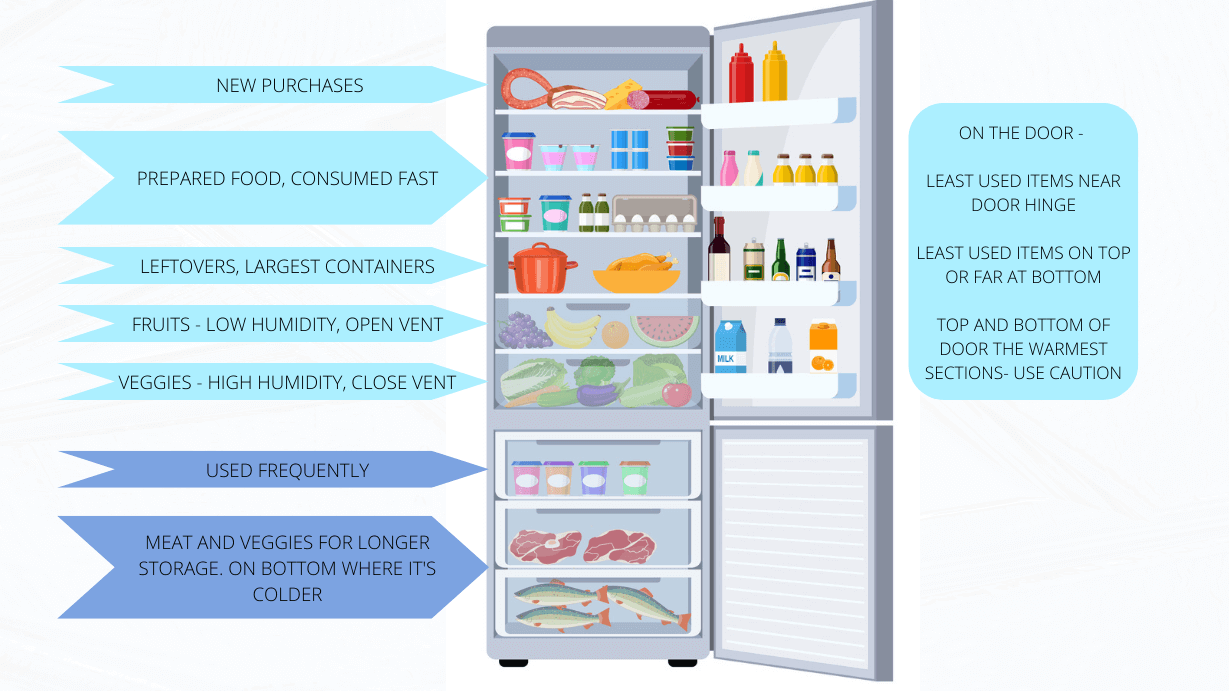Fridge Organization Chart

Saving You Time and Money
The organization of your refrigerator is essential for the longevity of your food and maintaining a healthy diet. Your refrigerator has multiple drawers that can be used to organize and store items based on their perishability. Find out what foods belong in each drawer and shelf and how long they should stay before relocating. Take a look at these fridge tips and organization chart.
Upper shelves (40°F)
The upper shelves should be reserved for refrigerated foods that need to be kept at a typical refrigerator temperature of 40°F. This includes milk, cream, and other dairy products (1 week), egg whites (2-4 days), hard cheeses such as cheddar and parmesan (1-2 months), and unopened eggs in their shells (3-5 weeks).
How Long Do Eggs Last In The Refrigerator?
-
- Milk and cream (1 week); egg whites (2-4 days); egg yolks, opened (2 days), unopened (3-5 weeks); hard cheeses (1-2 months)
-
- Eggs should be stored where they won’t be broken- to prevent bacteria from entering. Hard cheeses last longer than soft cheeses.
How Long Does Butter and Lunch Meat Last?
In general, you don’t have to worry about spoiling food in your fridge. This can be particularly true for dairy products such as butter and margarine. Butter should be stored at room temperature for one month before going bad. Margarine lasts up to two weeks after its original purchase date. In contrast, deli meats should always be kept in the refrigerator because they are highly perishable.
What About Fruit Juices and Salad Dressings?
-
- Fruit juice, opened (7-10 days) – Once a carton has been opened, fruit juice should be consumed within 7-10 days. The timing depends on how quickly you drink your beverage and whether or not it’s stored in the refrigerator. If you have any leftovers after this time, discard them because bacteria will most likely develop in an open container.
-
- Salad dressing (3 months) – Unopened salad dressings can last longer than 3 months. However, once they’ve been opened and exposed to air, they last less than 3 months before going bad. So, no part of the inside surface touches another part or utensil which may be contaminated. After opening a new dressing container or pouring some into a jar for storage at home, use a clean spoon.
Middle shelves/bins (35-40°F)
Don’t forget your fresh meats!
You’ll also find pre-cooked meats, hot dogs, and sausages here. It’s essential to keep these things separate from raw meat to avoid cross-contamination with bacteria. Cooked meat dishes can go here as well. That means casseroles, soups and stews are on this shelf. If you’ve made a big batch of spaghetti sauce for dinner but want to serve it later in the week, throw it in an airtight container and stick it in the fridge! A quick reheat later will make this dish as good as new.
How Long Does Meat Last In The Fridge?
Keep the fresh meat in the coldest part of your fridge. The organization chart above shows the new groceries on the top shelf. This area might be the coldest due to the fans at the top. Check where your fans are and store the meat accordingly. The following foods need to be cooked or eaten within two days:
-
- poultry (chicken, turkey, duck)
-
- ground meats such as beef and pork
-
- fish and shellfish (anchovies, clams/mussels/oysters)
The following foods can be eaten up to 3-4 days after opening the package:
-
- Pre-cooked meats (hams, sausages)
Beef, poultry, and seafood have a faint sweet smell. That’s normal. However, toss it out if it smells like garbage or is slightly rancid.
Cooked Meats, Casseroles, Soups, and Stews
You may wonder why we’re putting cooked meat, stews, and casseroles in this category. After all, they don’t spoil quite as fast as raw beef does. The problem is that they can still become cross-contaminated. If left out for too long, food items are dangerous (refrigerator temperatures are not cold enough to kill bacteria).
Cooked pasta dishes (5 days); cooked rice and grains (6 days): You might be thinking, “Wait, what? I thought pasta went bad after just a couple of days!” Yes, once the noodles come out of boiling water, they last only 2-3 days before going bad. But, if you refrigerate them immediately after cooking them, they will last up to 5 days.
More About Fresh and Hardboiled Eggs
Eggs, fresh in the shell or not scrambled or cooked (3-5 weeks), hard-cooked (1 week).
Eggs are a great source of protein and can be used to make various meals. You should keep eggs refrigerated at all times. The ideal place for storing your eggs is on the middle shelf of your refrigerator, where it’s the coldest and least exposed to light.
If you have more than one carton, store them side by side, so they stay cooler longer. Store hardboiled eggs (and any other soft-cooked eggs) separately from raw ones—hardboiled eggs will spoil faster than raw ones due to their higher moisture content.
Crisper Drawers
You’ll find a variety of fruits and vegetables in your crisper drawers. Fruit must be stored at a temperature of 45 degrees Fahrenheit, while vegetables should be held at 35 to 40 degrees Fahrenheit. Keep this in mind when storing fruits and veggies; there should never be any contact between the two types of produce, so keep them separated in each drawer.
Use low humidity for fruits and high humidity for vegetables. So, the vent must be open for fruits and closed for vegetables. It will control spoilage if you’re not in the mood to eat or forget those items. Take a look at the fridge organization chart for more information.
Suppose you’re planning on storing fresh produce for more than a few days. In that case, it’s best to wash them before storing them (the USDA recommends washing all produce after purchasing). This will help reduce bacteria growth and prevent spoilage! Then, place your clean produce into an airtight container or plastic bag—it might seem common sense, but moisture is the enemy!
Freezer Storage
All food in the freezer must be stored at 0 degrees Fahrenheit or less. By less, I mean negative 1, negative 2, negative 3 Fahrenheit, and so on. Store your raw meats away from the door, so frost doesn’t form. Make sure to wrap it up well, so no air is inside the packaging. Also, label the outside with the date, type, and portions inside. This will save you money and frustration trying to remember weeks later.
Conclusion
With so many refrigerators on the market, there are multiple ways to organize them. Some may take more creativity to manage, but you now have the fridge organization chart to help. Take the time to research and decide what’s suitable for your needs and budget. With some preparation and attention to detail, you will be well on your way to a better organized, more functional kitchen—and that’s never a bad thing.


